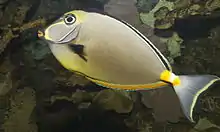Naso lituratus
Naso lituratus is a species of fish in the family Acanthuridae, the tangs and unicornfishes. Its common names include barcheek unicornfish, naso tang, and orange-spine unicornfish.[1]
| Naso lituratus | |
|---|---|
 | |
| Scientific classification | |
| Kingdom: | Animalia |
| Phylum: | Chordata |
| Class: | Actinopterygii |
| Order: | Acanthuriformes |
| Family: | Acanthuridae |
| Genus: | Naso |
| Species: | N. lituratus |
| Binomial name | |
| Naso lituratus (J. R. Forster, 1801) | |
Unique to members of Acanthuridae, including Naso lituratus, are the Epulopiscium bacteria. These bacteria influence the digestion of Naso lituratus, helping them process the algae in their diet.[2][3][4]
The Naso lituratus species can be found in the Indian Ocean and the Pacific Ocean. This species can be easily recognised by two bright orange forward-hooked spines on the caudal peduncle (the tail base), its orange lips and black face mask. The body is brownish grey with yellow nape and there is a broad black band on the dorsal fin. It reaches about 45 cm in length.[5]
It can be found on coral reefs, often in pairs.
References
- McIlwain, J., et al. 2012. Naso lituratus. In: IUCN 2012. IUCN Red List of Threatened Species. Version 2012.2. Downloaded on 03 June 2013.
- Miyake, Sou; Ngugi, David Kamanda; Stingl, Ulrich (2015). "Diet strongly influences the gut microbiota of surgeonfishes". Molecular Ecology. 24 (3): 656–672. doi:10.1111/mec.13050. ISSN 1365-294X. PMID 25533191.
- Fishelson, L. (1999-03-01). "Polymorphism in gigantobacterial symbionts in the guts of surgeonfish (Acanthuridae: Teleostei)". Marine Biology. 133 (2): 345–351. doi:10.1007/s002270050473. ISSN 1432-1793.
- Pollak, Peggy E.; Montgomery, W. Linn (1994-08-01). "Giant bacterium (Epulopiscium fishelsoni ) influences digestive enzyme activity of an herbivorous surgeonfish (Acanthurus nigrofuscus)". Comparative Biochemistry and Physiology Part A: Physiology. 108 (4): 657–662. doi:10.1016/0300-9629(94)90352-2. ISSN 0300-9629.
- Froese, Rainer and Pauly, Daniel, eds. (2008). "Naso lituratus" in FishBase. December 2008 version.

